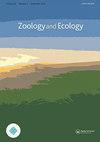The effect of climate change on habitat suitability and a distribution model of the Iranian fat-tailed gecko, Eublepharis angramainyu Anderson and Leviton, 1966 (Sauria: Eublepharidae) since the Last Interglacial to 2050
Q4 Environmental Science
引用次数: 0
Abstract
Surveying the role of climate changes on the species distributions in the past, present and future, and correlating these with changes in distribution ranges have attracted considerable research interest. The leopard geckos of the genus Eublepharis Gray, 1827 (family Eublepharidae), as a vicariate group, comprises six valid species distributed from Turkey through the Iranian Plateau to India, of which E. angramainyu, E. macularius and E. turcmenicus occur in Iran. In this study, we modelled the potential distribution areas for E. angramainyu and determined the suitable habitats in the past (the last interglacial [LIG] and mid-Holocene [MH]), present (1950–2000), and also predicted four scenarios in the future (2050) by using the maximum entropy approach (MaxEnt). The obtained models indicated very good values of the area under curve (AUC): LIG = 0.996 ± 0.003, MH = 0.996 ± 0.004, contemporary period = 0.995 ± 0.004, and the future = 0.997 ± 0.002. Precipitation of the coldest quarter and precipitation of the warmest quarter were the most important factors shaping the distribution of E. angramainyu. As it seems, climatic changes have been responsible for a southward shift in distribution and suitable habitats of E. angramainyu from the LIG (~150,000–120,000 years ago) to the future. The representative concentration pathway (RCP) 2.6 scenario model of the future predicted a much more restricted distribution and less suitable habitats due to radiation of the forcing level which reaches a value of around 3.1 W/m² by mid-century and returns to 2.6 W/m² by 2100.气候变化对伊朗肥尾壁虎栖息地适宜性的影响和分布模式,Euleppis angramainyu Anderson和Leviton,1966(Sauria:Euleppidae),自上次冰间期至2050年
调查过去、现在和未来气候变化对物种分布的影响,并将其与分布范围的变化联系起来,已经引起了广泛的研究兴趣。豹壁虎属,1827年(豹壁虎科),有6个有效种,分布于土耳其经伊朗高原至印度,其中E. angramainyu、E. macularius和E. turcmenicus分布于伊朗。本研究利用最大熵方法(MaxEnt)模拟了过去(末次间冰期[LIG]和全新世中期[MH])、现在(1950-2000年)四种情景下(2050年)赤子蟹的潜在分布区域,确定了赤子蟹的适宜生境。所得模型的曲线下面积(AUC)值较好:LIG = 0.996±0.003,MH = 0.996±0.004,当代= 0.995±0.004,未来= 0.997±0.002。最冷季降水和最暖季降水是影响芒草分布的最重要因素。气候的变化似乎是造成了从20世纪(~15万~ 12万年前)到未来的南移分布和适宜栖息地的原因。未来的代表性浓度路径(RCP) 2.6情景模型预测,由于辐射的强迫水平,到本世纪中叶将达到3.1 W/m²左右,到2100年将恢复到2.6 W/m²,因此分布将受到更大的限制,栖息地将更不适宜。
本文章由计算机程序翻译,如有差异,请以英文原文为准。
求助全文
约1分钟内获得全文
求助全文
来源期刊

Zoology and Ecology
Agricultural and Biological Sciences-Animal Science and Zoology
CiteScore
1.00
自引率
0.00%
发文量
1
 求助内容:
求助内容: 应助结果提醒方式:
应助结果提醒方式:


